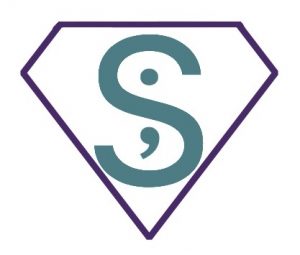Semicolons
Punctuation… what is it good for?
Don’t say, “Absolutely nothing!” Having worked with itty-bitties who have a tendency to not yet get the concept of run-on sentences, I know that the occasional punctuation mark can change gibberish into an interesting story. What I am skimming looks like word salad, but hand it back to the kid and ask for it to be read aloud and I wish I had a dollar for every time my response has been, “OHHHHH!”

So let’s all agree that punctuation is super important. But why is it equally as difficult to master? Well, like so many things with the English language, there are debates over correct usage and stylistic flair, and of course things change over time.
There are plenty of places on the interwebz where you can find answers to the difference between Chicago Manual of Style and APA on this or that rule. But if you were thinking of hiring Grammar Girl, you wouldn’t be on my site. So what follows is my no-nonsense view on punctuation.
*No punctuation was harmed in the writing of this blog. The views expressed here are not necessarily agreed upon by any major style guide.*
Today we will discuss semicolons, per the request of one of my favorite business gurus, Maria Ross.
So let’s get to the TLDR:
Don’t use them.
Semicolons… All they do is show you’ve been to college.
—Kurt Vonnegut
I’m sure that is going to start a meltdown for some of you. And others of you might pick on me for using one in my LinkedIn profile. But the easiest way to deal with semicolons is to eliminate them.
Most of the time, there is another, safer punctuation mark that can be used in place of wherever you want to put that semicolon. It could be the simple and ever-loving period. If that doesn’t work, you probably meant to use a comma anyway. Or on occasion, a dash.
But let’s just say you want to know how to use them. There are two general purposes for a semicolon.
Super Comma!

Sometimes you have a list that is so complicated that you have a hard time distinguishing what the individual elements of the list are.
Example:
My friends include Ivy, a gorilla, my hero, Georgianna, and Cleotilde, who is cute and cuddly.
How many friends do I have here?
You can use a semicolon as a super comma to separate the individual friends.
Example:
My friends include Ivy; a gorilla; my hero, Georgianna; and Cleotilde, who is cute and cuddly.
How many of you thought that Ivy was a gorilla? Using semicolons as a higher level comma shows that I am talking about four friends here. (Just like there is a debate about the Oxford/serial comma, you can debate about that last semicolon, too.)
The most obvious use for this is lists of cities and states/countries.
Example:
I have lived in Baltimore, MD; Waianae, HI; and both Melbourne and Brisbane, Australia.
The Joiner
The other use of semicolons is the one that is most abused. A semicolon can be used to connect two very closely related sentences. It is as if they are so close, you don’t want the readers to fully separate the ideas, which they might do if you use a period.
That’s fair. I think semicolons have their place in complicated technical writing. Writing where the paragraphs are long and you might need to show the close relationship of two ideas without adding more words. I can see it there.
Some people say you should only use it for very short sentences. I honestly don’t know why that is a thing. Maybe this is for people who get dinged on writing too many sentences that are too short? (To be fair, that is how I used it in my LinkedIn, I know! But I was illustrating a point, guys!)
Here is the thing, though… I see the biggest abuse of semicolons in the fiction world. For fiction, why do you need them at all? Generally, this style of writing embraces short paragraphs. Fiction breaks all of the rules about 3-5 sentences in a paragraph that my teachers tried to beat me with. (And to be fair, I tell the itty-bitties this rule about paragraphs in their writing classes… but it is much more of a rule in non-fiction.)
So if fiction allows for short paragraphs, maybe even ones with only a sentence or two, the fact that two sentences are in the same paragraph makes them closely related. You don’t need a semicolon to show how smart you are!
Example: (Yes, this was the entire paragraph!)
To Deedee, George had died years before; the man she had married had turned into a rogue, unable to be a good husband or father.
To Deedee, George had died years before. The man she had married had turned into a rogue, unable to be a good husband or father.
To Deedee, George had died years before—the man she had married had turned into a rogue, unable to be a good husband or father.
There are plenty of fiction authors who use semicolons correctly and even I wouldn’t notice them before I started editing. Now I look at them on the page and decide how I would change it if I had edited the book. (It just goes to show that you need to have a conversation or two with your editor to be sure your styles mesh. When I see a semicolon in a client’s writing, I always open up dialog about it and what impressions the author wants to convey.)
Rules for Using Semicolons
If you absolutely insist on using semicolons, please follow these rules:
- The ideas on BOTH sides of the semicolon need to be complete sentences in their own right. Neither side should be a fragment, or else you just need a comma.
- Use them sparingly. If they start to look like spots on a Dalmatian, you need to stop. Seriously… if you can’t translate the intimacy of your ideas without this unnecessary mark, you should reassess your writing.
Yup, that’s it. Just two rules. I don’t want to make it too complicated since you already decided to break my rule of don’t use them.
Questions? Comments? Want to know how I would change your semicolon use?
Drop me a line in the comments. Also, let me know what punctuation mark you want me to address next!

Leave a Reply